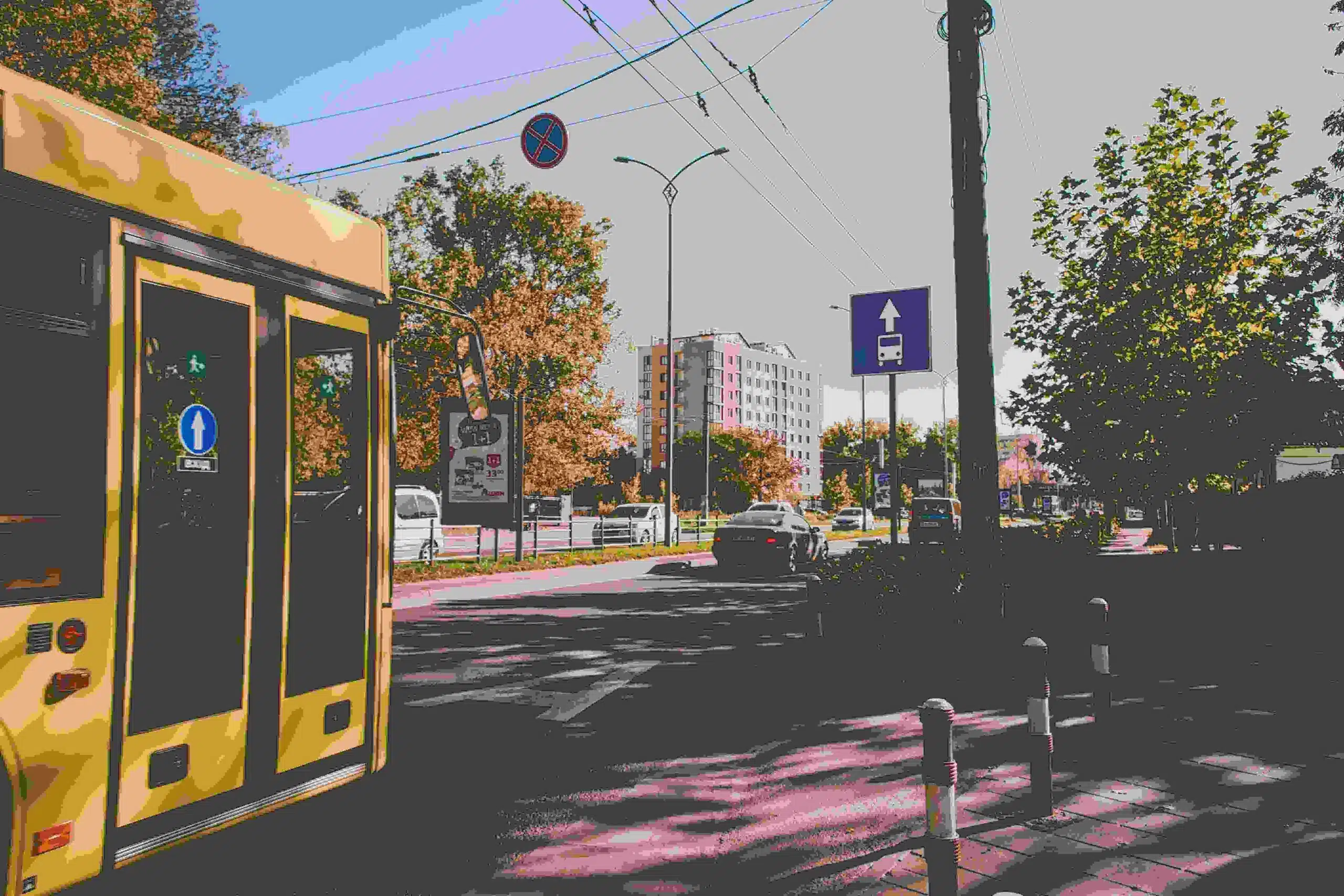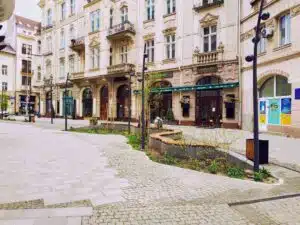In February, TUMIVolt partner city Lviv, Ukraine was awarded Honorable Mention at the 2021 Sustainable Transport Award ceremony by the Institute for Transportation and Development Policy (ITDP). Lviv applied for the award based on the city’s achievements in reconstructing the Main Railway Station Square, as well its Sustainable Urban Mobility Plan (SUMP) to promote public transport, specifically electric public transport, and develop the city’s cycling infrastructure.
Since Lviv adopted its SUMP in February 2020, the western Ukrainian city with about 1 million residents has set itself on a path of creating a more people-centric city in the next decade. The city has already celebrated many wins, so it’s worth taking a closer look at how Lviv addressed its particular challenges to come up with forward-thinking solutions that will change the face of the city.
Lviv background
In many ways, the layout of Lviv is like other European cities. It’s compact, filled with a combination of new and very old, historic buildings, and it has a radial structure in which most of the main streets lead out from the center. Much of the lifeblood of the city, such as educational and cultural institutions and jobs, are concentrated in the city center. As such, seven out of ten tram and trolleybus routes and over half of the bus routes run through or near the central part of the city.
The neighborhoods within are mostly self-sufficient, and the majority of residents, around 50%, get around by using public transit. About a quarter travel by personal car, 18% walk and 6% cycle.
The challenge
Since the 1990s, car ownership and usage has increased in Lviv, causing congestion and pollution in the city center. Additionally, as Lviv modernized, large house developments have emerged, often in transit deserts. The city began to experience problems moving people efficiently, as the streets weren’t designed to handle such an influx of passenger vehicles alongside public transit, which was getting increasingly slow, especially around rush hour.
The state of Lviv’s mobility network not only led to inefficient movement, but also to negative health impacts from car emissions and noise pollution. Additionally, the city had unattractive pedestrian infrastructure and public spaces with poor conditions for walking and cycling, as well as for the able-bodied, elderly, etc, and road collisions plagued the city.
Creating a Sustainable Urban Mobility Plan in Lviv
In 2018, the Lviv City Council and Deutsche Gesellschaft für Internationale Zusammenarbeit (GIZ) GmbH began working together on the “Integrated Urban Development in Ukraine” project. Through continuous involvement with the public and an open process of development, this working group laid the groundwork for Lviv’s SUMP, which was approved by the Lviv City Council in February 2020. Like many other SUMPs, this long-term urban development plan involves a 15-year vision and a detailed four-year action plan that encourages review and adjustment every four years, the latter being currently developed. The main goals of SUMPs are:
- Vision Zero road fatalities
- People friendly city
- Efficient, comfortable, eco-friendly public transport
- Optimized motor vehicle traffic in the city
- Increase bicycle adoption
- City of short distances
- Coordinated mobility management and high competence levels among staff
So what kind of a vision does SUMP lay out for Lviv in 2035? The hope is that it will be an attractive city with high quality of life. As more residents use improved, green public transit or are encouraged to walk and cycle by better pedestrian infrastructure and bike lanes, air and noise pollution will decrease, as will traffic congestion and accidents.
The compactness of the city will no longer cause bottlenecks, but rather allow for integrated urban structures in line with the concept of a 15 minute city, with plenty of pleasant public spaces.
“Smart mobility” solutions will further reduce car usage, such as demand-responsive minibuses, car-sharing services, dockless e-bike and e-scooter shares, etc. Even the delivery of goods will shift as either e-bike-powered or autonomous robotic last-mile logistics becomes the norm within the city.
One example of an eco-friendly, people-friendly infrastructure project included in the SUMP is the construction of the Green Line (concept). The Green Line will be a 6km route specifically for pedestrians and cyclists leading from the remote, yet populous, residential district of Skyhiv all the way to the city center, allowing residents and workers to reach the main hubs via green and healthy travel. The designs for the Green Line also include making the space a park of sorts, a place that citizens can use for recreation as well as mobility.
Lviv’s progress so far
The SUMP was developed in frame of the GIZ project Integrated Urban Development in Ukraine (ISU), commissioned by the German Federal Ministry for Economic Cooperation and Development (BMZ) and the Swiss State Secretariat for Economic Affairs (SECO). In line with the SUMP, Lviv’s urban transport scene has already changed drastically over the past few years. Let’s review some of the greatest accomplishments.
- Lviv Rudanskoho Street
- Lviv Main Railway Station
The reconstruction of Main Railway Station Square
Lviv Railway Station serves 24,000 long-distance passengers per day. In terms of passenger traffic, Lviv Railway Station is the second-largest in Ukraine after Kyiv Central Station. In line with Lviv’s goals of efficiency in regards to public transport and car travel, as well as Vision Zero goals, the square in front of the main train station has undergone massive structural changes that demonstrate the prioritization of public space, pedestrians and public transport users. The new design takes a space that was disorganized, with no real parking scheme, no safe access for cyclists or pedestrians, and no priority for public transport, and gives it order and safety in the form of dedicated bus lanes, dedicated pedestrian and cycling infrastructure, and priority to electrified Tram and Trolleybus fleets.
New cycling infrastructure
Lviv is actively developing cycling infrastructure with more than 100km built already. New bicycle lanes are in the works along Knyahyni Olhy Street and Chornovola Avenue, a key section of the cycle network that allows northern and southern regions to be linked together through the city center. Bicycle lanes along Sakharov Street and Horodotska Street are also in development. To create a new quality standard for bicycle lanes, parallel to much of the bicycle infrastructure is the development of pedestrian space, public transport, landscaping and parking.
Improvements to public transport
Also on Chornovola Avenue is the plan to launch dedicated lanes to public transport. This corridor is the main city artery with 23 public transit routes. By creating a dedicated section, the city was able to speed up public transport by 9 minutes.
Construction on the dedicated tram lane on Svintsitskoho Street involved the removal of several parking spots on the roadway. This resulted in reduced travel time on the tram line by more than 15 minutes.
Finally, through cooperation with the European Bank for Reconstruction and Development, Lviv was able to purchase 50 new electronic trolleybuses, which not only improve travel efficiency, but also give passengers a better experience with features like air conditioning.
New and improved public spaces
Lviv is taking streets from cars and giving them back to the people. The city has opened streets, one of them Rudanskoho Street, and converted them to pedestrian areas, making them attractive public spaces.
Additionally, Lviv is opening modern playgrounds continuously, such as the one near St. Georgs Cathedral, on Teodora Square opposite the Media Library. They are high quality, atypical playgrounds that are beginning to emerge in Lviv, a sign that the city is encouraging youngsters to also spend more time using non-motorized transport and engaging with public spaces.

Lviv Playground near St Georg Cathedral
Concluding this insights on SUM of Lviv
Lviv still has a long way to go, but with a flexible and comprehensive SUMP that encourages peoples’ engagement with their city, it is no doubt on its way towards a greener, more sustainable urban environment.


